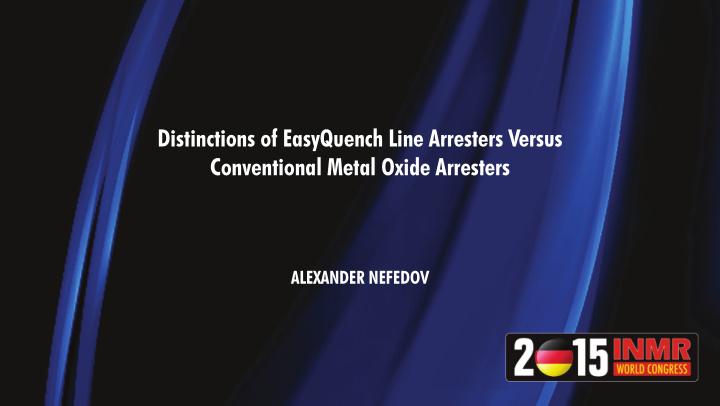



Distinctions of EasyQuench Line Arresters Versus Conventional Metal Oxide Arresters ALEXANDER NEFEDOV
Distinctions of EasyQuench Line Arresters Versus Conventional Metal Oxide Arresters Alexander Nefedov Streamer Electric Inc. 2015 INMR World Congress, 18-21 October, 2015 2015 (c) Streamer Electric Inc. All right reserved
Content 1. Introduction 2. Company info 3. Technology 4. Testing 5. Application 6. Summary and conclusion 2015 (c) Streamer Electric Inc. All right reserved
Introduction 2015 (c) Streamer Electric Inc. All right reserved
Company info 20 years of operation in the field of lighting protection Over 20 patents 4 main locations all over the world: St.Petersburg, Moscow – HQ, domestic sales, R&D, manufacturing 1000 Chur, Rapperswil (Switzerland) – international 800 sales, R&D 600 Beijing (China) – China representative 400 Bangkok (Thailand) – South-East Asia 200 representative 0 1996 1998 2000 2002 2004 2006 2008 2010 2012 2013 2014 Over 1 million pcs. installed in 12 countries 2015 (c) Streamer Electric Inc. All right reserved
Company info Utilities in 12 countries are already familiar with EasyQuench line arresters Russia Belorussia Kazakhstan Ukraine China Iran UAE Vietnam Indonesia Thailand Brazil Switzerland Malaysia (upcoming) 2015 (c) Streamer Electric Inc. All right reserved
Technology EasyQuench ™ system a) top view; b) front view, initial stage of spark discharge; 2 а ) 4 c) front view, final stage of spark discharge; 3 d) discharge chamber cross-section, side view. 2 1 b) 4 1 – silicon rubber profile; 2 – intermediate electrodes; 4 2 3 – discharge chambers; 1 4 – spark discharge channel. c) d) 2015 (c) Streamer Electric Inc. All right reserved
Technology Examples of EasyQuench line arresters “Distribution class” line arrester SAi20z ReDDragon – specifically developed for China Line arresters for protection against direct lighting strikes 2015 (c) Streamer Electric Inc. All right reserved
Testing “Follow current interrupting test” Power grid simulating Lighting impulse generator circuit parameters: parameters: I eff = 1…7 kA I max = 1…30 kA Typical current impulses: U eff = 1…60 kV Direct lighting strike: 8/55 µs Back flashover: 1/50 µs U max = 250 kV Different operational principle -> different follow current interrupting test Follow current = short- circuit current in the location of arrester’s installation Several kA vs several A for EGLA (IEC 60099-8) 2015 (c) Streamer Electric Inc. All right reserved
Testing “Follow current interrupting test” Voltage, kV Current, kA Time, ms 2015 (c) Streamer Electric Inc. All right reserved
Testing Lighting discharge capability test 18 discharge operations (as per IEC 60099-8) 230 µs @ 16 kA => 2.4 C (limited by lab capability) Complete performance and characteristics conservation (verified by follow current interrupting test) 2.4 C for a “distribution class” arrester ( U rated = 24 kV) 2015 (c) Streamer Electric Inc. All right reserved
Testing High current impulse withstand test Very important for conventional metal-oxide arresters Not that important for EasyQuench arresters, but can be easily passed 4/10 µs @ 65 kA => “distribution class” arresters 4/10 µs @ 100 kA => can be achieved with insignificant modification of EasyQuench system 2015 (c) Streamer Electric Inc. All right reserved
Application Footing resistance High footing resistance isn’t always bad For EasyQunech arresters it provides additional follow current limiting effect No need to arrange separate grounding “Natural” footing resistance of a pole is enough 2015 (c) Streamer Electric Inc. All right reserved
Application Pilot projects Areas with high lighting activity (>15 strikes/km 2 /year): Faster and clear results of pilot projects; Advantages become sharper and more obvious. “Bold” utilities: Eager to try something new because of previous negative experience with conventional lightning protection solutions; Ready to continue cooperation and equip more lines. 2015 (c) Streamer Electric Inc. All right reserved
Application Pilot projects Main test sites: Malaysia Indonesia Thailand Vietnam China Brazil Positive results and feedback from utilities 2015 (c) Streamer Electric Inc. All right reserved
Summary and conclusion Conclusion 1. EasyQuench line arresters have been developed to protect overhead lines from cutoffs and provide reliable and uninterruptable power supply of customers. 2. Operational principle of EasyQuench line arresters is based on dissipation of excessive energy of a lightning-caused overvoltage and power arc quenching by the means of a large number of elementary discharge chambers. 3. EasyQuench line arresters for distribution lines are able to transfer at least 2.4 C with maintaining all main characteristics, including follow current interrupting capability. High current impulse test with amplitudes up to 100 kA is also not an issues for EasyQuench line arrester. 2015 (c) Streamer Electric Inc. All right reserved
Summary and conclusion Conclusion 4. Follow current interrupting test for EasyQuench line arresters is performed in a very special way and includes two types of simultaneous impacts – lighting impulse plus power arc. The value of follow current in such test is equal to fault current value of modern distribution networks. 5. Footing resistance of a pole is not so crucial for EasyQuench line arresters and might be considered as an extra current limiting factor. 6. Pilot projects in areas with high lightning activity help to verify performance of EasyQuench line arresters within relatively short period of time and reveal superiority over conventional solutions. 2015 (c) Streamer Electric Inc. All right reserved
Thank you for your attention! 2015 (c) Streamer Electric Inc. All right reserved
Recommend
More recommend